A Planeswalker’s Guide to Zendikar: Akoum
This content was deleted from the Magic website during an update. The original page can be accessed via Wayback Machine here.
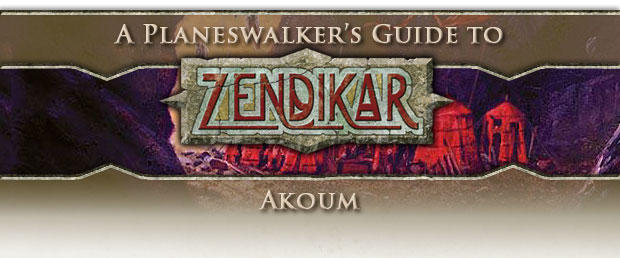
Edged beauty” defines the volcanic continent of Akoum more than any other concept—the crystalline fields shimmer in every imaginable color beneath the sun, but the deceptively sharp edges of even the most mundane surface stones will slice through leather and flesh if an unwary traveler should slip and fall. The surface can reach incredible temperature extremes, as the omnipresent silicate stone reflects the sun’s glaring light and will cook an unprepared traveler during the day just as quickly as that cold stone will freeze one at night.
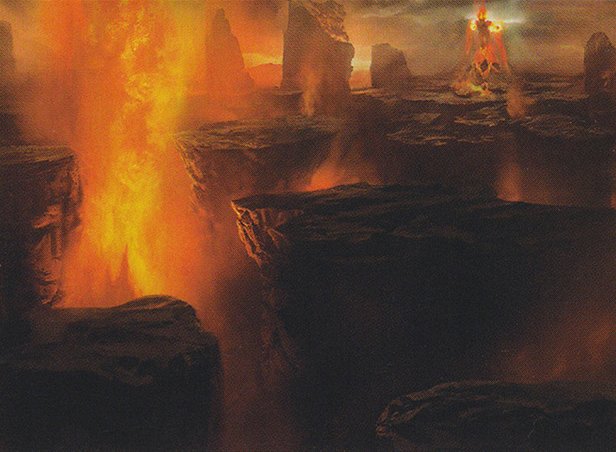
Akoum is primarily aligned with red mana, as befits such a heavily volcanic region, but the crystal fields on the surface and the spires of semi-reflective rock help provide a white mana tie to the region as well. Beneath the surface is an impossibly old world, and many layers beneath the surface lay trapped pockets from ages past. From time to time a volcanic burst will bring gases and earth trapped for centuries up onto the surface. For a time, the surface of Akoum will burst into beautiful and often-times bizarre flora. The elvish pilgrims that tend these regions refer to the event as a “Life Bloom,” but don’t tell that to anyone who gets trapped within the volcanic event, or who gets eaten by one of the carnivorous plants that often take root in its aftermath. These regions provide intense links to green mana, but these Blooms tend to survive only a year or two at the most.

“My boots are in ribbons. The steeds’ hooves bleed. We carry too much tinder and not enough water. We would have no motivation to continue to the ruins if it were not that it’s just as far back to Akoum’s coast again.”
– Journal of Prina Wey

Geological Instability
At the center of the sprawling region is a massive supervolcano—not precisely dormant, but in the last millennial cycle, there have been few major eruptions. Instead, because of Zendikar’s dynamic force known as the Roil, the whole region is plagued by a constant low-level instability. Whereas the Roil on the continent of Tazeem seems to affect the land from above, the Roil seems to affect Akoum from below. Magma flows constantly flood and clear tunnels, gases from deep within the earth are thrust to the surface, and seismic activity can bring down a rain of crystal shards, more deadly than any volley of arrows. In short, Akoum is not ideal real estate for a sentient being looking to make a home. The mineral lava is liquid at extreme temperatures, but as it cools, it quickly crystallizes. Cooling Akoum lava will produce large jagged outcroppings of crystalline rock, the crystal lattices visibly emerging from the glowing-hot liquid stone.
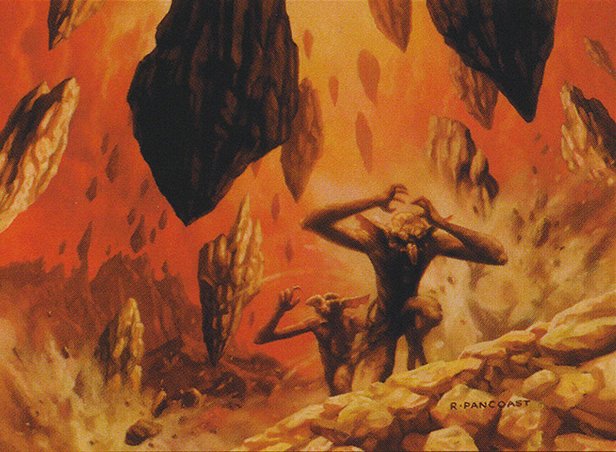
Lifeforms
Despite the barrenness of much of the Akoum landscape, life does tend to find a way to thrive in the cracks. Aggressive silver and blue grasses take root in volcanic stone and spread rapidly, providing meager fare for the larger fauna of the region. Creatures that can survive the jagged land tend to be as tough and dangerous as their home—no mammals, other than the ubiquitous rodents, have managed much of a foothold. Instead, most creatures are either insectile outright, or have some insect-like features; carapace or shells are essentially required survival traits, as the jagged volcanic crystal has weeded out species that lacked such defenses.
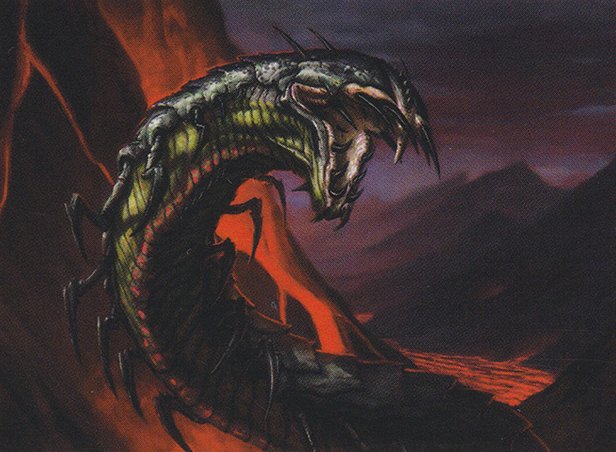
Deadly Coasts
The coasts of Akoum are a deathtrap to travelers. Seismic activity and spires of volcanic glass make landing a ship onto the mainland a near impossibility. The eastern shores are safest, but never safe. After braving a journey filled with krakens and storms, it is not uncommon for a ship to meet its end within sight of the Akoum shores, the hull torn apart on jagged underwater crystals, essentially invisible to a lookout’s eye. There are no permanent ports. The coastline changes significantly every year to volcanic eruptions, above and below water, and seismic activity that sends coastal shelves into the ocean itself. Still, upon hearing that a ship has been sighted, people from nearby settlements will do all they can to help bring a ship in—that ship that might carry valuable supplies impossible to glean on the continental mainland.
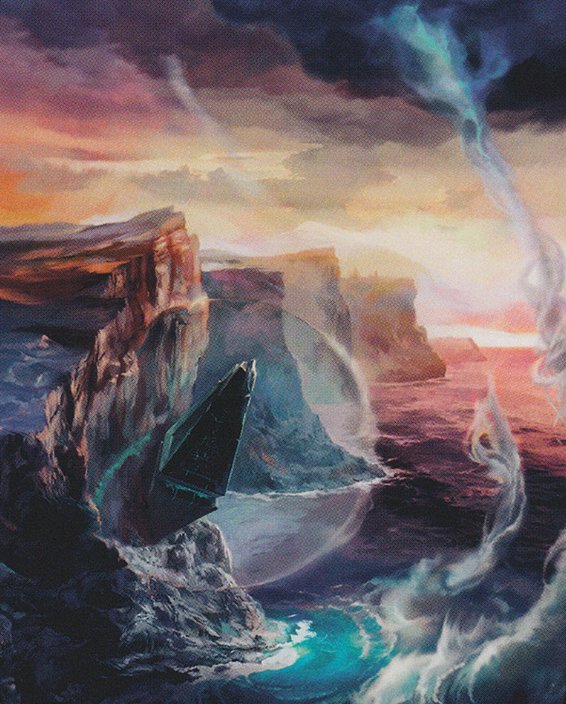

“The coastline is not as bad as they say. Every time the wind changes, just ask the madman raving in your brig which way to tack. You’ll be ashore in no time, one way or another.”
– Sachir, Akoum Expeditionary House

Teeth of Akoum
The northern reaches of Akoum become more mountainous. The Teeth of Akoum are a series of mountain ranges that are essentially impassable without some means of flight or a very experienced and clever guide.
Civilization clings tenaciously to the Teeth of Akoum, which try to shake it off from time to time. Sentient residents of the Teeth include the humanoid races of Zendikar, the occasional sphinx, and even a golem that went rogue from its original function of ruin defense, for causes unknown.
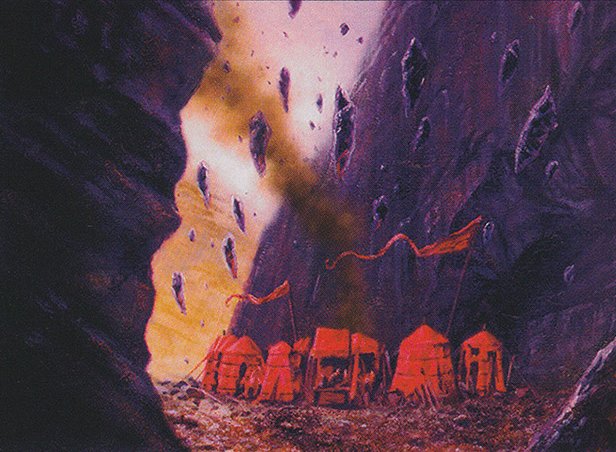
League of Anowon
A small settlement of explorers can be found high in the Teeth. It’s a small training camp founded and led by the vampire known as Anowon, the Ruin Sage. The League of Anowon trains dungeoneering mages, or as they prefer to call themselves (with a touch of irony in their voices), “liberators”—mages taught acrobatics and “extractive archaeology” in order to best survive ancient ruins and bring home items of magical importance. A fully trained mage of the League of Anowon can make an easy living freelance or as a mage-for-hire. Reaching the camp is no small task, and usually involves taking a griffin from the town of Affa below. Leaders at the camp are rarely physically whole. Teachers tend to take up the role after suffering a career-ending injury—a lost limb or eye, or contact with a crippling magical effect. The camp often attracts preeminent visitors, delvers in their prime who claim to come to the camp for the prestige but who are often looking for expendable student volunteers to help on their next mission.
For all that the school wishes to project an image of forthright respectability, this training camp is frequently shut down for months at a time due to drake attacks, rogue mana storms, seismic activity, or detonations due to misuse of magical artifacts.

“Law is a hazy concept on the wastes of Akoum. Occasionally you hear of an explorer making a claim of theft, some missing idol or pathway stone that got ‘taken’ from their possession. More often than not, though, it’s just that the League of Anowon swooped down into the ruins and found it before ’em.”
– Josala Marang, freeblade of Affa

Affa
This is a mostly human settlement at the base of the Teeth, though elves, kor, and even the occasional vampire will call it home for a time. A river flows down from the Teeth of Akoum and provides the town with one of the few safe, reliable sources of fresh water in the continent. It serves as the major trading hub in the region, and a launching point for glory seekers who wish to head out to the ruins. Goblins, especially from the Lavastep warren, bring minerals, materials, and any doodads that they can’t figure out how to use. While rare, someone who knows what they’re looking for might find an undiscovered treasure among the trash at the Affa bazaar.
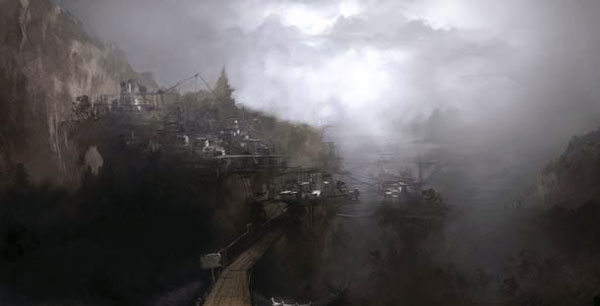
The Goma Fada Caravan
By far the strangest city in the region is not a traditional city at all. Goma Fada, literally “The City that Walks,” is an enormous caravan of wandering kor, humans, and a few elves that moves at a slow pace through Akoum. The several thousand people that make up the caravan actually represent one of the largest “settlements” in all of Akoum. Hundreds and hundreds of huge, sturdy carts comprise homes, shops, eateries, even agriculture—fig trees and similar hardy plants are grown in the dirt-filled backs of wagons.
Knowing that Akoum is death to any who stay in the same place for long, and knowing that resources can appear and disappear at a moment’s notice, Goma Fada has answered that challenge by never sitting still long enough to be caught napping. Huge packbeasts and hurda giants pull enormous carts carrying cisterns full of water or granaries full of food. It can be rough living, as the dangers of Akoum move quicker than the caravan, but the “city” is tenacious and has managed to survive thus far.
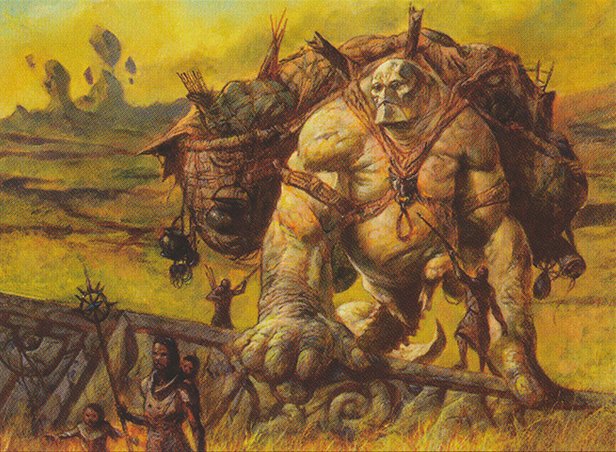

“All the major routes of the region—the Rogah Throughway, Akoum’s Belt, the Pass of Woe—were carved by the wagon-wheels of Goma Fada. The greatest explorer of Akoum isn’t Sachir or Kala the Bold—it’s the Walking City itself.”
– Chronicle of Vurundi

Tal Terig
Rising hundreds of feet high out of Akoum’s basin is the ruin site known as Tal Terig, or “The Puzzle Tower.” One of the most famous sites on the continent, the ruin’s exterior is a pillar of seemingly randomly assembled geometric shapes of all sizes—ranging from tiny decorative cubes jutting from the surface to enormous tetrahedrons, making up a significant portion of the structure, twenty feet on a side. The angles and lines of the tower appear to defy the bounds of logic; some have reported headaches and nosebleeds after looking at its surface for short spans of time.
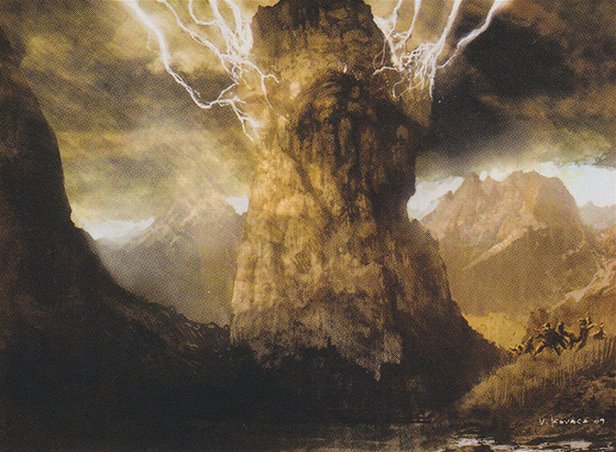
The portion of Tal Terig that juts above the surface of the ground is a tiny fraction of the huge tower’s size. While twenty or so floors jut out into the sky, another two hundred lay buried beneath the crystal and stone.
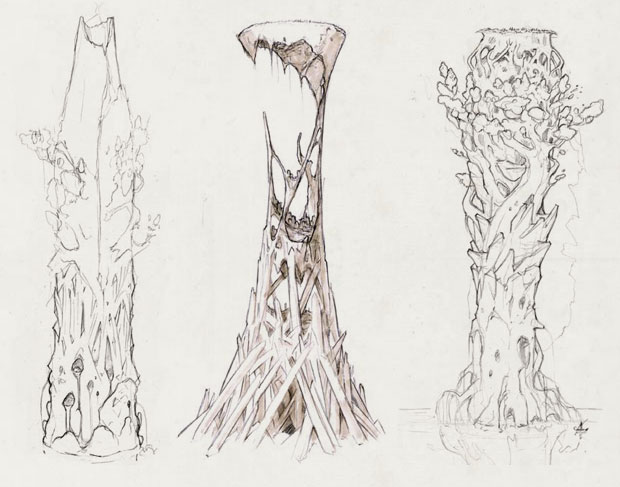
As expected, the site is as deadly as it is valuable. Spirits haunt the halls, as do many constructs and traps placed to guard against graverobbers. Magical traps line each and every hall, and the magic of the vaults is such that the halls of the spire rotate and cycle, ensuring that no trap learned by explorers stays exactly the same for long. The sound of grinding stone carries for miles from the tower, and it’s a sound that tells the few creatures brave enough to serve as guides that all their hard-earned information about the layout of the ruin has just become obsolete.

“Before you go, sign here, will you? It’s a… guestbook of sorts.”
– Hion, proprietor of the Affa Inn and keeper of the Names of the Lost Travelers

Ora Ondar
Most “Life Blooms” in Akoum, the sudden bursts of growth that occur after a tectonic upheaval, last only a year or two. A notable exception is Ora Ondar, sometimes called the Impossible Garden. This oasis of growth in the harsh, angular setting of Akoum has lasted almost a hundred years. A mid-sized, multiracial settlement of mostly elves now thrives there—home to roughly 8,000—and the tenders of Ora Ondar, who call themselves “nourishers,” do everything in their power to help it last. The settlers have built homes into the stone crannies of a five-tiered outgrowth of rock that juts dramatically out of the crystalline basin. Each layer is home to a different era’s flora—gigantic flowers and ferns, thorned vines, giant pitcher plants and flytraps, and on the top layer, a grove of carefully cultivated kolya trees, which produce a mango-like fruit with magical properties.
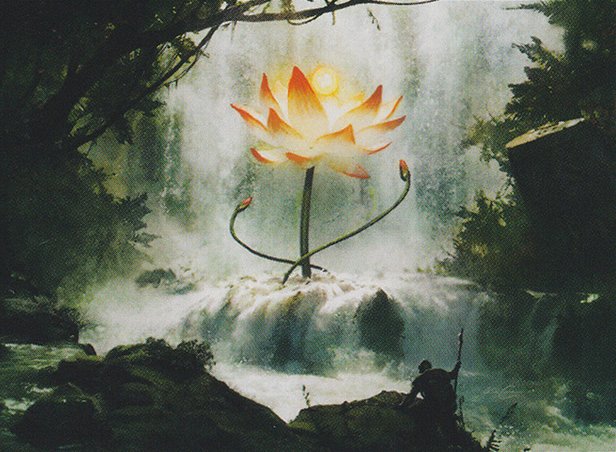
Eating a kolya fruit is a risky proposition, as the trees serve as natural mana extractors. Most of the time, eating a kolya fruit will simply be an enjoyable culinary experience; the flesh of the fruit is sweet and tangy. In rare instances, however, the fruit will cause a change in the eater, granting great strength or intelligence if the eater is lucky, or causing strange physical properties to manifest: a phosphorescence to the eater’s blood that causes his veins to visibly glow in the dark, or a dramatic change to the color of the eater’s eyes.
A cult of elves believe the kolya tree to be a gift from the gods and eat the fruit religiously. These cultists claim that continued eating of the fruit grants them wisdom and visions, but after years of eating the fruit, fatal mutations will usually develop. The elf druid Sef Amaran is the current leader of the cult, and the fruit has disfigured him just as it has granted him many gifts. Now blind and insensate much of the time, his followers dutifully collect his fevered rantings as prophecy.
The Khalni Stone
In actuality, Ora Ondar grows around an ancient artifact, the Khalni Stone. This artifact is a powerful mana refractor, and the druids’ success in tending the site comes from an amplification of the effort that the elves have put into maintaining it. Many researchers of the stone have posited that it lies somewhere in the forests of Akoum, but nobody has yet theorized that it could be the source of Ora Ondar. If someone were to learn the truth, the elves and other settlers would do everything in their power to strike back at any who threatened this, their most sacred and life-supporting site in Akoum. The Stone would be a prize that few planeswalkers or magical practitioners of any sort would cease pursuing were its location to become known.
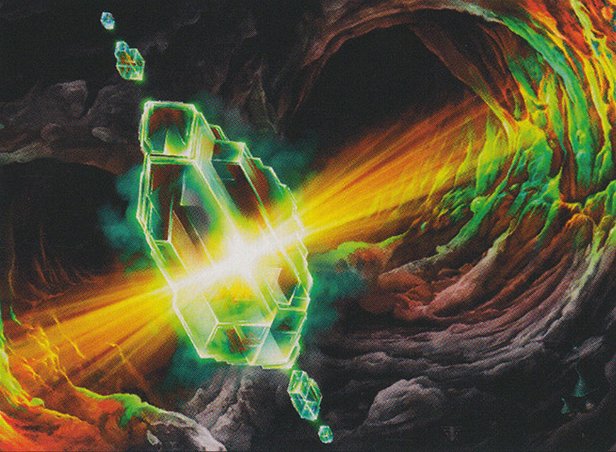
Igneous Glens
Other than the sporadic Blooms, plant life is sporadic throughout Akoum. Conditions of temperature and moisture change so rapidly that larger plant life can rarely adapt. Often a life bloom will end when a lava flow erupts nearby. From time to time, a particularly fast-moving flow will leave behind what’s known as an igneous glen; the plant life is essentially “flash fossilized”, leaving behind a region of statues of the plants and animals that once lived there. While the wandering kor and humans see these regions as beautiful and a sign of good luck, the elves will often destroy them when found, feeling that no matter how aesthetically appealing, a monument to the destruction of life should not stand.

“Believe it or not, this elf traveled everywhere barefoot. She said it let her walk longer distances without shocking her knees, and let her ‘sense’ the trail below her. Never saw her come back through here, though. She said she had a mission to tear down some statuary in Akoum, where her friend died or somesuch nonsense. Way I heard it, she’s still there, haunting some lava field, her bare feet preserved forever in the rock.”
– Leodo, tavernkeeper

Waterscouts
Rainfall comes to Akoum in violent torrents during the winter season, and the spring will often see the surface transformed, lakes atop crystal beds will form overnight, and water will cascade across the rock spires—a beautiful sight, and fleeting as anything else within Akoum. These pools and rivers last days or months before the next tremor causes the water to drain away beneath the surface. The kor and humans who sparsely populate the region send waterscouts—part architect, part explorer, part engineer—to respond to these flows, and try to direct the water into cisterns that serve as a supply for the year to come. With very few static sources of water to draw from, water is a precious commodity.
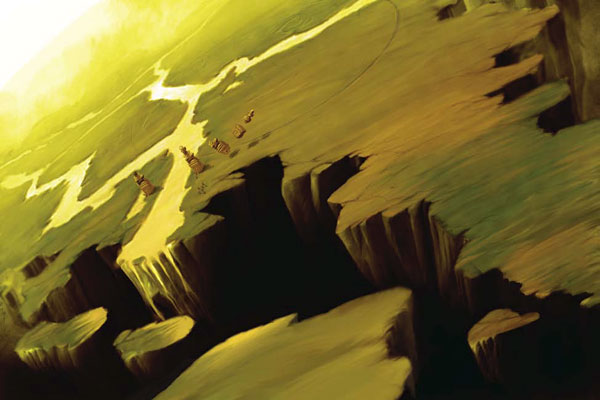
Glasspool
This is the one fixed body of water of any notable size in the region—a huge lake, strangely hexagonal in shape, over two miles across. The water is always cool, clean and clear—and yet most intelligent creatures steer well clear of it. Its name is derived from the complete stillness of the surface of the water at nearly all times. Seismic activity somehow fails to affect it. Even when the surrounding lands are shaken by quakes, the lake remains magically still. Amphibious aquatic drakes make the lake their home, drawn perhaps to this, the only reliable source of blue mana in the Akoum mountain range.
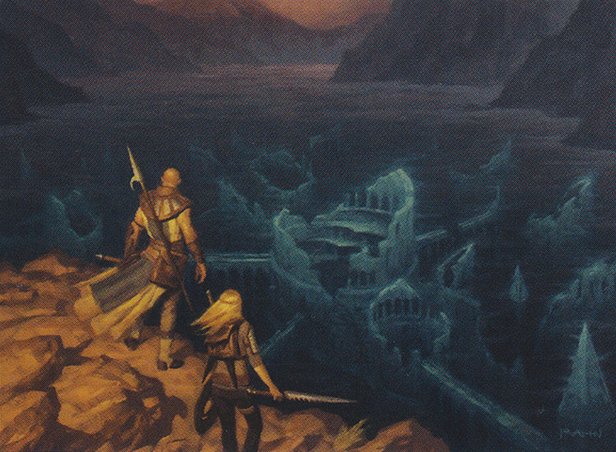
Ior
Explorers have spotted a ruin site at the bottom of Glasspool from the height of a nearby jagged peak. Though little is known about its origins, some researchers have posited that it was once an ancient center of learning, home to a repository of some civilization’s magical knowledge.
